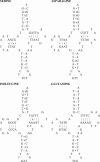Comparative analysis of gender-associated complete mitochondrial genomes in marine mussels (Mytilus spp.)
- PMID: 16322521
- PMCID: PMC1456209
- DOI: 10.1534/genetics.105.047159
Comparative analysis of gender-associated complete mitochondrial genomes in marine mussels (Mytilus spp.)
Abstract
Marine mussels of the genus Mytilus have an unusual mode of mitochondrial DNA (mtDNA) transmission termed doubly uniparental inheritance (DUI). Female mussels are homoplasmic for the F mitotype, which is inherited maternally, while males are usually heteroplasmic, carrying a mixture of the maternal F mitotype and the paternally inherited M genome. Two classes of M genomes have been observed: "standard" M genomes and "recently masculinized" M genomes. The latter are more similar to F genomes at the sequence level but are transmitted paternally like standard M genomes. In this study we report the complete sequences of two standard male M. edulis and one recently masculinized male M. trossulus mitochondrial genome. A comparative analysis, including the previously sequenced M. edulis F and M. galloprovincialis F and M mtDNAs, reveals that these genomes are identical in gene order, but highly divergent in nucleotide and amino acid sequence. The large amount (>20%) of nucleotide substitutions that fall in coding regions implies that there are several amino acid replacements between the F and M genomes, which likely have an impact on the structural and functional properties of the mitochondrial proteome. Correlation of the divergence rate of different protein-coding genes indicates that mtDNA-encoded proteins of the M genome are still under selective constraints, although less highly than genes of the F genome. The mosaic F/M control region of the masculinized F genome provides evidence for lineage-specific sequences that may be responsible for the different mode of transmission genetics. This analysis shows the value of comparative genomics to better understand the mechanisms of maintenance and segregation of mtDNA sequence variants in mytilid mussels.
Figures






References
-
- Altschul, S. F., W. Gish, W. Miller, E. W. Myers and D. J. Lipman, 1990. Basic local alignment search tool. J. Mol. Biol. 215: 403–410. - PubMed
-
- Ballard, J. W. O., 2000. a Comparative genomics of mitochondrial DNA in members of the Drosophila melanogaster subgroup. J. Mol. Evol. 51: 48–63. - PubMed
-
- Ballard, J. W. O., 2000. b Comparative genomics of mitochondrial DNA in Drosophila simulans. J. Mol. Evol. 51: 64–75. - PubMed
-
- Ballard, J. W. O., and M. D. Dean, 2001. The mitochondrial genome: mutation selection and recombination. Curr. Opin. Genet. Dev. 11: 667–672. - PubMed
-
- Blier, P. U., F. Dufresne and R. S. Burton, 2001. Natural selection and the evolution of mtDNA-encoded peptides: evidence for intergenomic co-adaptation. Trends Genet. 17: 400–406. - PubMed
Publication types
MeSH terms
Substances
Associated data
- Actions
- Actions
- Actions
LinkOut - more resources
Full Text Sources
Miscellaneous

